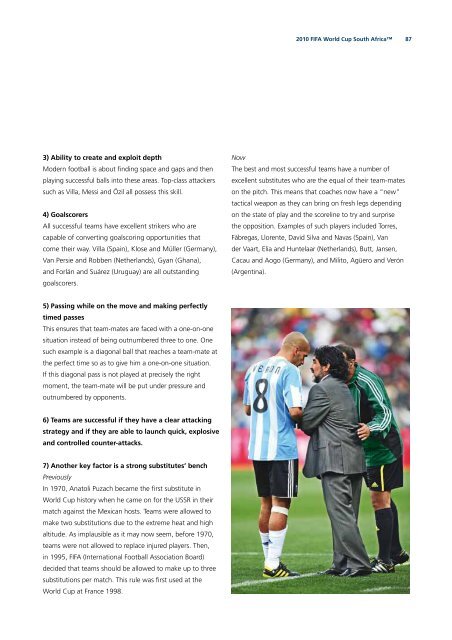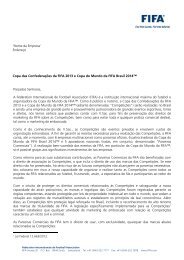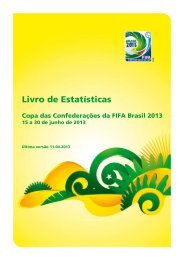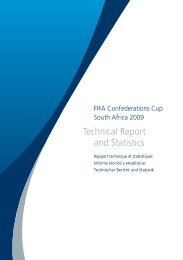Create successful ePaper yourself
Turn your PDF publications into a flip-book with our unique Google optimized e-Paper software.
3) Ability to create and exploit depth<br />
Modern football is about fi nding space and gaps and then<br />
playing successful balls into these areas. Top-class attackers<br />
such as Villa, Messi and Özil all possess this skill.<br />
4) Goalscorers<br />
All successful teams have excellent strikers who are<br />
capable of converting goalscoring opportunities that<br />
<strong>com</strong>e their way. Villa (Spain), Klose and Müller (Germany),<br />
Van Persie and Robben (Netherlands), Gyan (Ghana),<br />
and Forlán and Suárez (Uruguay) are all outstanding<br />
goalscorers.<br />
5) Passing while on the move and making perfectly<br />
timed passes<br />
This ensures that team-mates are faced with a one-on-one<br />
situation instead of being outnumbered three to one. One<br />
such example is a diagonal ball that reaches a team-mate at<br />
the perfect time so as to give him a one-on-one situation.<br />
If this diagonal pass is not played at precisely the right<br />
moment, the team-mate will be put under pressure and<br />
outnumbered by opponents.<br />
6) Teams are successful if they have a clear attacking<br />
strategy and if they are able to launch quick, explosive<br />
and controlled counter-attacks.<br />
7) Another key factor is a strong substitutes’ bench<br />
Previously<br />
In 1970, Anatoli Puzach became the fi rst substitute in<br />
World Cup history when he came on for the USSR in their<br />
match against the Mexican hosts. Teams were allowed to<br />
make two substitutions due to the extreme heat and high<br />
altitude. As implausible as it may now seem, before 1970,<br />
teams were not allowed to replace injured players. Then,<br />
in 1995, <strong>FIFA</strong> (International Football Association Board)<br />
decided that teams should be allowed to make up to three<br />
substitutions per match. This rule was fi rst used at the<br />
World Cup at France 1998.<br />
<strong>2010</strong> <strong>FIFA</strong> World Cup South Africa<br />
Now<br />
The best and most successful teams have a number of<br />
excellent substitutes who are the equal of their team-mates<br />
on the pitch. This means that coaches now have a “new”<br />
tactical weapon as they can bring on fresh legs depending<br />
on the state of play and the scoreline to try and surprise<br />
the opposition. Examples of such players included Torres,<br />
Fàbregas, Llorente, David Silva and Navas (Spain), Van<br />
der Vaart, Elia and Huntelaar (Netherlands), Butt, Jansen,<br />
Cacau and Aogo (Germany), and Milito, Agüero and Verón<br />
(Argentina).<br />
87







